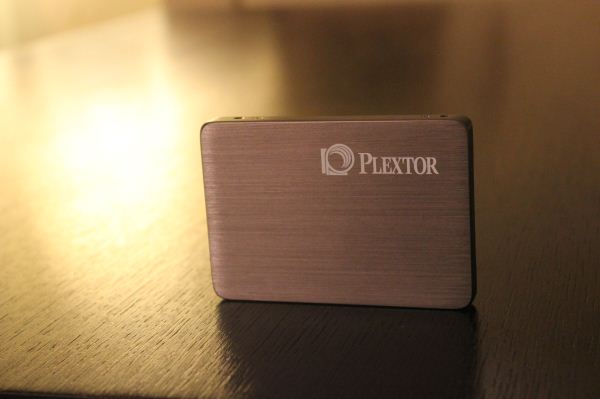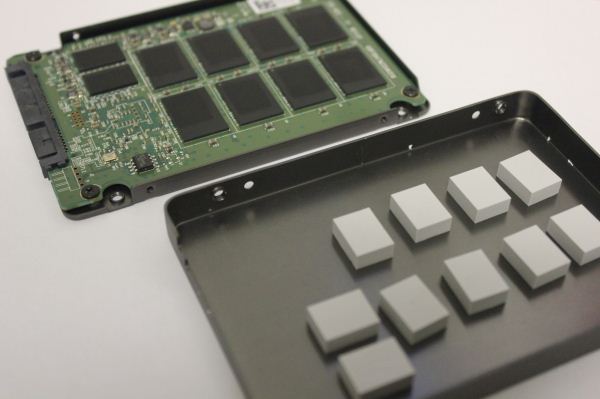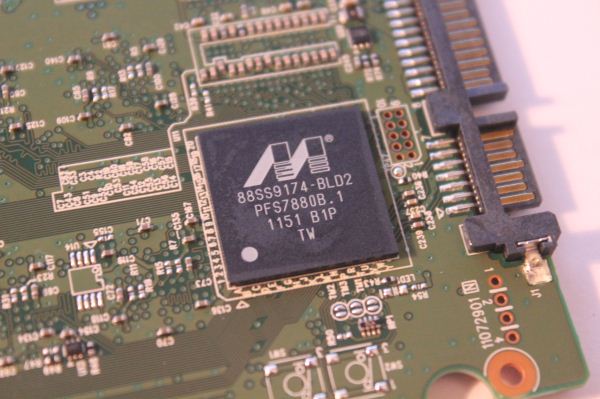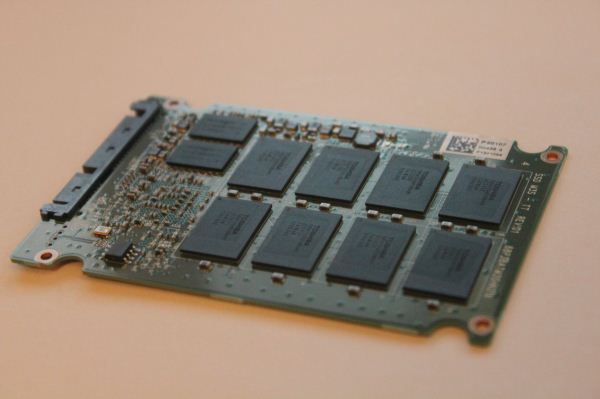The Plextor M3 (256GB) Review
by Kristian Vättö on April 5, 2012 3:05 AM ESTThe Plextor M3
Plextor sent us a 256GB model of their M3 series. Below is a table containing the specifications of their M3 line.
| Plextor M3 Specifications | ||||
| Model | PX-64M3 | PX-128M3 | PX-256M3 | PX-512M3 |
| Raw NAND Capacity | 64GiB | 128GiB | 256GiB | 512GiB |
| Formatted Capacity | 59.6GiB | 119.2GiB | 238.5GiB | 476.9GiB |
| Number of NAND Packages | 8 | 8 | 8 | 8 |
| Number of die per Package | 1 | 2 | 4 | 8 |
| Sequential Read | 520MB/s | 510MB/s | 510MB/s | 525MB/s |
| Sequential Write | 175MB/s | 210MB/s | 360MB/s | 445MB/s |
| 4K Random Read | 55K IOPS | 70K IOPS | 70K IOPS | 56K IOPS |
| 4K Random Write | 40K IOPS | 50K IOPS | 65K IOPS | 30K IOPS |
| Cache (DDR3) | 128MB | 256MB | 512MB | 512MB |
The Plextor M3 is available in all the standard capacities. In the light of the performance specifications, the M3 looks very promising. It beats its closest match, the Crucial m4, in all aspects. It's very competitive even with SandForce based SSDs and especially the stated random read figures are great.
| NewEgg Price Comparison (4/2/2012) | ||||
| 64GB | 128GB | 256GB | 512GB | |
| Plextor M3 | $110 | $180 | $340 | $660 |
| Crucial m4 | $88 | $155 | $315 | $630 |
| Intel 520 Series | $110 | $180 | $345 | $800 |
| Samsung 830 Series | $105 | $185 | $300 | $780 |
| OCZ Vertex 3 | $90 | $178 | $340 | $770 |
Price wise the M3 is not the cheapest SSD, especially in the smaller capacities. There is about $10-15 premium in the 64GB and 128GB models but 256GB and 512GB models are more competitively priced. Crucial's m4, however, comes in as a cheaper option than the M3 at every capacity so that will be a key matchup where Plextor has to win on performance or come down in pricing.
The external design of Plextor M3 is very solid. When I first saw it, it reminded me of Samsung 830 with its brushed metal finish. Only the Plextor logo has been printed on the front—The model and other important information are printed on a sticker on the back of the drive. The drive package includes a 3.5" bracket, quick installation guide, and a software CD, which includes a clone&backup utility along with performance analyzer. Plextor is giving the M3 a top notch 5-year warranty as well.
Each of the main components (controller, NAND devices, and DRAM) have their own little thermal pad. Since the chassis is also made out of metal, heat dissipation should not be a problem.
Inside we find Marvell’s 88SS9174-BLD2 controller (or just 9174). This is the same controller that's in Crucial's m4, but the firmware is custom developed by Plextor. It’s actually a bit surprising, yet very refreshing, to see a Marvell based SSD for a change. Everyone seems to have a SandForce solution these days. We have seen that Marvell can be competitive; you just need to take the time to customize the firmware to get good performance. The stock SandForce firmware is fast enough, so it's obvious that many companies choose to go with the easiest option.
Flip the PCB and we find eight Toshiba 24nm 2-bit-per-cell MLC NAND devices. That’s coupled with two 256MB DDR-1333 chips from Nanya, giving a total of 512MB of DDR3 cache.
Toshiba uses a Toggle-Mode interface and the current iteration (2.0) of Toggle-Mode NAND is good for up to 400MT/s per interface. Rating speed by transfers is a bit annoying as it doesn't tell us the actual bandwidth—for that we need the width of the channel and transfers per second. The channel in this case is 8 bits wide, so that works out to be 3.2Gbps per interface, or 400MB/s. With eight NAND packages, the maximum throughput works out to be 3200MB/s, over four times more than what SATA 6Gb/s can provide. Of course, reading from NAND and dumping the data into a register is one thing; it's another matter to actually transfer the data to a host controller over the interface.
We want to provide a quick word about firmware updates before we go into benchmarks. The drive came with FW 1.01, which was the latest at that time. Plextor has recently released FW 1.02 which is supposed to fix some issues but all our tests have been done using FW 1.01. Plextor is not claiming increased performance in the release notes of the update. The actual process of updating the firmware is very simple. Download a small ISO (~3MB) from Plextor's site, burn that to a CD or USB stick and boot from that. Press Enter and it automatically flashes the drive. I even had all my other drives plugged in and there was no problem.
The Test
| CPU |
Intel Core i5-2500K running at 3.3GHz (Turbo and EIST enabled) |
| Motherboard |
AsRock Z68 Pro3 |
| Chipset |
Intel Z68 |
| Chipset Drivers |
Intel 9.1.1.1015 + Intel RST 10.2 |
| Memory | G.Skill RipjawsX DDR3-1600 2 x 4GB (9-9-9-24) |
| Video Card |
XFX AMD Radeon HD 6850 XXX (800MHz core clock; 4.2GHz GDDR5 effective) |
| Video Drivers | AMD Catalyst 10.1 |
| Desktop Resolution | 1920 x 1080 |
| OS | Windows 7 x64 |
Our regular readers may notice that my testbed is not exactly the same as Anand's. Anand's setup is based on Intel's motherboard with H67 chipset, whereas mine is an ASRock board based on Intel's Z68 chipset. The important bit here is that both feature native SATA 6Gb/s support and both setups use the same drivers. Other features and components don't really have an effect on SSD testing. For example the average CPU usage during write speed tests is less than 5%.














113 Comments
View All Comments
jwilliams4200 - Thursday, April 5, 2012 - link
And still you are avoiding the issue, which is your reviews have been stating that Sandforce SSDs have better steady-state performance than other SSDs like the Plextor M3, when you have no objective test results to back up such statements.I provided links to two other reviews that showed that the Plextor M3 has substantially better steady-state performance than several Sandforce SSDs. Those reviews (mostly) used the recommendations in the industry standard SNIA SSD test protocols.
All you have is arbitrary measurements, and NOT EVEN THE SAME TESTS RUN ON the Plextor M3 and Sandforce SSDs, and you make the claim that Sandforce is better. That is really not at all credible.
Such misleading states are doing an injustice to your loyal readers. Please do the right thing and correct your misleading claims about the relative steady-state performance of Sandforce SSDs, and also start work on developing an objective, consistently-applied steady-state test for future reviews.
Anand Lal Shimpi - Thursday, April 5, 2012 - link
Neither of the reviews you linked to provided steady state data for client workloads.Keep in mind that we run a ton of data internally that shapes our conclusions.
Here's a chart of high queue depth, steady state performance (sequential precondition, 4KB random write QD32):
http://images.anandtech.com/graphs/graph5719/45462...
The precondition is with incompressible data (iometer 1.1.0-rc1, fully random data pattern) as is the 4KB random write pass.
I'm not sure how others measure steady state random write but most controllers, with standard 7% spare area, fall off significantly after being exposed to random writes for an extended period of time.
Take care,
Anand
jwilliams4200 - Saturday, April 7, 2012 - link
The reviews I linked to follow the industry-standard SNIA guidelines for measuring steady-state performance, at least, an abbreviated version of the guidelines.In contrast to anandtech.com, which has completely arbitrary non-random workloads, in violation of the SNIA guidelines. Even worse, anandtech.com runs different tests on Sandforce SSDs than on non-Sandforce SSDs, and then claims that one SSD is better than another based on the results of different tests!
That is highly misleading and doing an injustic to your readers. anandtech.com really needs to do the right thing here.
rw1986 - Friday, April 6, 2012 - link
Jwilliams -- can you offer any supporting evidence to your claim that the Everest 2 is a "rebadged Marvell 88SS9187"? You mention this in several threads but you have not offered any evidence to support that notion...why should we believe you?jwilliams4200 - Thursday, April 5, 2012 - link
For those who are not familiar with the SNIA SSD testing protocols and specifications:http://www.snia.org/tech_activities/standards/curr...
http://www.snia.org/forums/sssi/pts
kyuu - Friday, April 6, 2012 - link
Yeah, we get it. Thanks.Myself, I think that Anand's finding on low write amplification on the Sandforce drives after long-term, real-world usage is more important, and more relevant, than some arbitrary and artificial benchmark standard. Just because some organization says such and such doesn't mean that any alternative is automatically bunk, or that reviewers aren't credible if they don't follow their procedures to the tee.
jwilliams4200 - Saturday, April 7, 2012 - link
Actually, it does mean that reviews are not credible if they don't follow the appropriate SNIA SSS guidelines. The SNIA SSS test specifications were developed by contributors from more than 20 companies in the industry and were carefully reviewed and compiled to form an objective standard for characterization of the performance of solid state storage devices.The reviews from anandtech are not credible at all, because they do not follow any objective standards at all, let alone the SNIA SSS protocols. Anand even admitted that they do not even run the exact same tests on all SSDs. This makes the results completely arbitrary and unreliable.
LokutusofBorg - Saturday, April 7, 2012 - link
You're a walking, talking example of logical fallacies. And you lost all credibility when you claimed the Vertex 4 is a Marvell controller without proof.Anand has been setting the bar for SSD analysis and testing for years now, and you suddenly come into a comments thread and start sounding the warning that his tests are flawed?
The TRIM/torture tests in every review obviously don't try to compare SSDs against each other. All other tests are objective and run the same on each SSD being compared in the graphs. Anand clearly stated this, and you deceptively or ignorantly misinterpreted what he said. Anybody with half a brain reading these comments can see that you need to spend less time typing and more time reading.
jwilliams4200 - Wednesday, April 11, 2012 - link
http://www.anandtech.com/show/5741/ocz-confirms-oc...Bobsy - Thursday, April 5, 2012 - link
Am I glad to see these comments about Plextor being well-known and highly reputable. I remember upgrading my 486 DX2-66 computer with a Plextor optical drive (4X read-only) that I had paid $400. Plextor hardware was leaps and bounds ahead of anything else at the time. The opening comments from the author made me smile and it was obvious that the author was a young person. It is true that we have not heard about Plextor much in quite some time, at least not in terms of their products being the best.